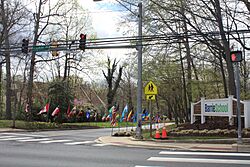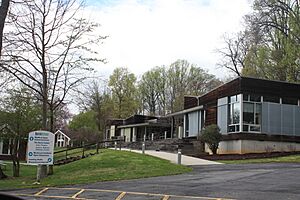Barrie School facts for kids
Quick facts for kids Barrie School |
|
|---|---|
 |
|

Entrance to the Barrie School (April 2025)
|
|
| Address | |
|
13500 Layhill Road
, 20906
United States
|
|
| Coordinates | 39°04′40″N 77°02′56″W / 39.0778674°N 77.0490025°W |
| Information | |
| Funding type | Private |
| Established | 1932 |
| Founder | Frances Littman Seldin |
| CEEB code | 210951 |
| Head of school | Ben Thrash |
| Faculty | 59 FTE |
| Grades | 3 months through Grade 12 |
| Number of students | 333 |
| Student to teacher ratio | 6.1 |
| Hours in school day | 7.5 |
| Campus size | 45 acres (180,000 m2) |
| Campus type | Suburban |
| Color(s) | Blue and gold |
| Team name | Mustangs |
Barrie School is a special private school for students from 3 months old all the way up to 12th grade. It's located near Washington, D.C. in Montgomery County, Maryland. The school is a nonprofit, which means it focuses on its mission rather than making money.
The school has three main parts, all on the same campus. The Lower School is for children from 3 months old through fifth grade. It uses the Montessori method, which helps kids learn by exploring and doing things themselves.
The Middle and Upper School uses a different approach. Students learn through projects and real-world experiences. The school campus has many buildings, a swimming pool, and two ponds. Barrie School used to have a horse riding program, but it closed in 2020.
Contents
History of Barrie School
How the School Started
Barrie School was founded in 1932 by Frances Littman Seldin. It began as a preschool called the Peter Pan School. This first school was in the Mount Pleasant neighborhood of Washington, D.C.. Frances Seldin was a graduate of Columbia University.
Moving to Takoma
In 1939, the school moved to a new, larger campus in the Takoma neighborhood. This new location was a big, 17-acre campus in the city. The school's name was changed to Barrie School when older grades were added. This new name honored author J. M. Barrie, who created the Peter Pan story.
Mrs. Seldin believed in a "progressive" way of teaching. This meant she wanted students to learn by doing and experiencing things. She was influenced by famous educators like Maria Montessori. Barrie School was unique because it welcomed students from different backgrounds. It also offered year-round programs and long hours to help working parents. The school used many ideas from Maria Montessori, like learning through projects and having different age groups in one class.
Moving to Montgomery County
In the 1950s, Mrs. Seldin bought a large 45-acre property in Montgomery County, Maryland. The school started using this new location in 1958. This move helped the school continue its goal of teaching in a natural environment. The Barrie Camp also moved to this property.
By 1976, the original campus in Washington, D.C., was closed. All the remaining classes moved to the Layhill Road property. This new campus had space for 265 students.
The high school (Grades 9–12) was closed for a few years, from 1974 to 1982. This happened because Mrs. Seldin passed away, and the school needed to sell the old campus. Also, new building rules in Montgomery County limited how many students could enroll.
The high school reopened in 1982, just in time for the school's 50th anniversary. Barrie's Upper School became the first Montessori High School in the United States. That same year, the Barrie Institute for Advanced Montessori Studies began. It offered special training for teachers who wanted to teach older students using the Montessori method.
New buildings were finished on the Layhill Road campus in 1991. This brought all the students, from the youngest to the oldest, together on one campus again.
Barrie Institute for Advanced Montessori Studies
The Barrie Institute for Advanced Montessori Studies was started in 1980. It is located on the Barrie School campus. This institute offers special training programs for teachers. These programs help teachers learn how to combine traditional teaching methods with Montessori ideas. Teachers from many countries, including the United States, Canada, China, and South Korea, have completed these programs.
Notable Alumni
- William C. Smith: A Maryland Senate Officer


